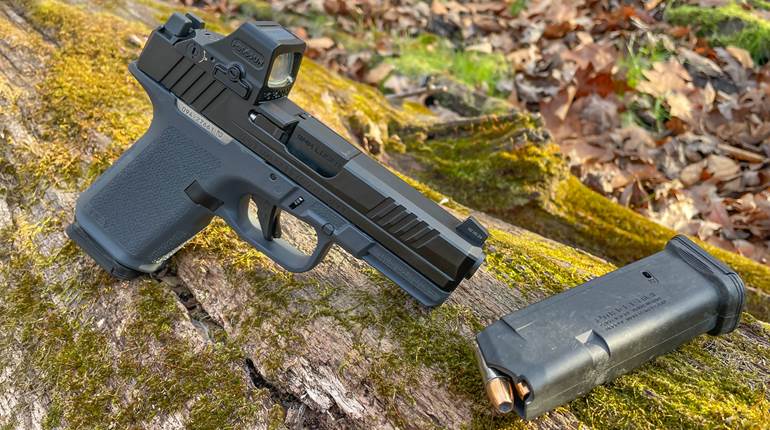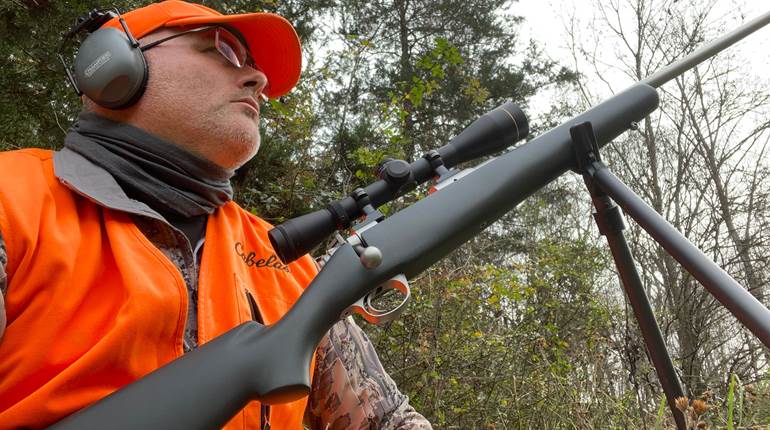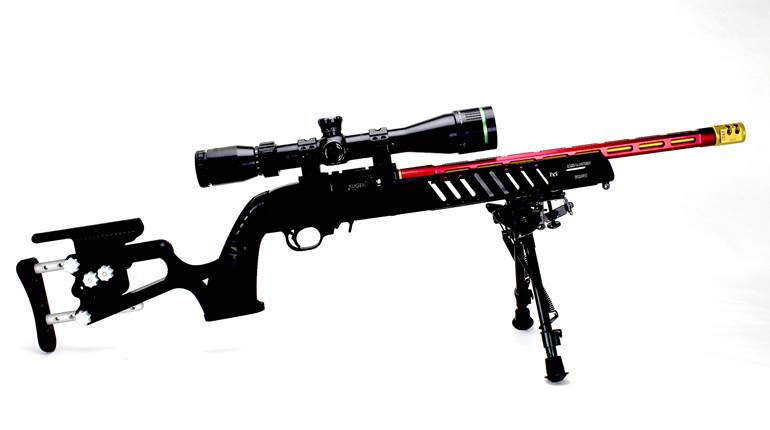
In the six-plus decades since Nosler’s 1948 introduction of the Partition, the company has continually re-evaluated and refined past designs, as well as added new features, in an effort to deliver discerning big-game hunters some of the most effective, technologically advanced hunting bullets. Today, the Nosler lineup includes five “premium” big-game rifle projectiles: Partition, Ballistic Tip, AccuBond, E-Tip and Solid.
Nosler’s Partition, Ballistic Tip and AccuBond bullets are manufactured via impact extrusion rather than the more-commonly encountered “cup-and-draw” method employed by many manufacturers. Nosler literature reports that the method allows the company to “… dictate jacket wall thickness, base thickness, boat tail angle and thickness, internal diameters and, in the case of Partition bullets, … [create] a front and rear jacket cavity.” Furthermore, the company proclaims the process permits jacket-taper designs to produce an ideal blend of accuracy, expansion, penetration and weight retention, all on a consistent basis. Although the Partition, the Ballistic Tip and AccuBond feature impact-extruded jackets, the jacket designs are not identical, nor are the bullets’ performance characteristics.
There is a disadvantage to using impact extrusion, though: The process is time-consuming. For example, Nosler reports that the Partition takes upward of four times longer to manufacture than a standard cup-and-draw bullet. As this limits output, naturally prices of these projectiles are higher than those of bullets manufactured through more rapid production processes, such as cup-and-draw.
Nosler’s newest bullets, the E-Tip and the Solid, differ greatly in manufacture, construction and performance from the company’s previous offerings. While the E-Tip’s method of manufacture remains undisclosed, the jacket-less E-Tip and Solid, the latter of which is turned from bar stock, also command a premium.
Indeed, each Nosler projectile is unique. Not only do they vary in design and manufacture, but also in external and terminal ballistic traits. So, how do you know which one is the best for your next big-game hunt? Let’s take a look.
Partition
The result of John A. Nosler mistakenly sketching two bullet shapes atop one another, adding a partition to separate the two, and then making the image a reality, the Partition was envisioned as providing reliable expansion—at high and low velocities—deep penetration and what Nosler deemed the optimal weight retention: 65 to 70 percent. The Partition’s performance parameters came to fruition through ingenious design features.
First, the forward section of the Partition’s gilding metal jacket progressively thickened until meeting the partition, or cross-member, and was designed for easy upset—velocities as low as 1800 fps. In fact, the front lead-alloy core was expected to be shed to enhance the bullet’s wounding capabilities, or “tissue damage by fragmentation,” as John A. Nosler explained in Nosler Reloading Guide 6. From the cross-member rearward, the jacket thinned until reaching the bullet’s base, at which point it was crimped to retain the rear core and resist deformation.
How does the Partition work? Essentially, during expansion the jacket’s front portion peels rearward uniformly—forming several similar petals—until arrested by the partition. In the process, the front core, or a large portion thereof, is shed; however, because the rear section remains unchanged, the projectile penetrates deeply. Considering the Partition is 64 years old, and is still as effective as ever, its design genius cannot be seriously doubted. Interestingly, the same “partition” concept is also utilized in the company’s Partition-HG handgun hunting bullets.
Partitions are available in calibers and weights ranging from a .22-cal., 60-grain spitzer to a .45-cal., 500-grain protected point.
Ballistic Tip
In creating the Ballistic Tip, Nosler sought “ … a no-compromise bullet for consistent accuracy at long range.” To achieve this goal, Nosler incorporated a sharp polycarbonate tip into the company’s already aerodynamic, boattail-profile Solid Base bullet (introduced in 1972), which in itself was a refinement of the Zipedo (released in 1965). Both have since been discontinued. “I thought that a plastic tip would be attractive, appealing and give spectacular performance,” said Nosler.
The Ballistic Tip’s polycarbonate tip, which was color-coded per caliber, not only eliminated nose deformation, which surely increased accuracy, but, when combined with the boattail base, also bettered the projectile’s aerodynamic qualities, thereby enhancing its external ballistics—precisely what was required for long-range applications. The tip also initiated expansion, particularly at lower velocities, which were, and remain, a reality at longer distances.
Like its parent, the Ballistic Tip Hunting bullet—as opposed to the Varmint variant—featured a tapered, gilding metal jacket that progressively thickened toward the base; however, instead of having an open base, such as the Partition, the Ballistic Tip ended in the Solid Base design. The jacket geometry and skiving, combined with the polycarbonate tip, enabled rapid, reliable expansion at velocities as low as 1600 fps, and the Solid Base acted as a platform for the jacket and lead-alloy core to roll back on. Weight retention of the Ballistic Tip varied by caliber, projectile weight and impact velocity, but was typically 50 percent.
Because of its light construction—less so in heavy-for-caliber weights—the Ballistic Tip Hunting was, and remains, recommended for thin-skinned, lightly boned game, such as antelope and white-tailed deer, though some hunters also prefer them for slightly larger North American quarry, such as black bear, caribou and elk. It is recommended that, if pushed near the maximum functional velocity of 3100 fps, or if used for bigger game animals, the heavier bullets, which are of stouter construction, should be selected.
In addition to the Ballistic Tip, Nosler, in partnership with Winchester, also manufactures the Combined Technologies (CT) Ballistic Silvertip bullet, which is identical in construction but features the black Lubalox coating. The coating reportedly reduces friction, pressure and fouling.
Although not the first tipped projectile, the 1985 introduction of the Ballistic Tip forever changed bullet design—Nosler’s and the competition’s. Today, all major bullet makers have tipped-bullet variants. Ballistic Tip Hunting bullets are available in calibers and weights ranging from .24-cal., 90 grains to .32-cal. (8 mm), 180 grains.
AccuBond
Described by Nosler as “… the ultimate marriage of long-range accuracy, penetration and controlled expansion,” the AccuBond—introduced in 2003—features the best traits of its brethren, and it was designed to maintain bullet integrity at high velocities, yet not forego the aerodynamic qualities of the Ballistic Tip. Although the Ballistic Tip design was commendable, when pushed beyond its limitations weight retention became a concern. To combat that, Nosler made the Ballistic Tip stouter; however, with numerous newly introduced magnum cartridges propelling bullets at ever-increasing velocities, that simply wasn’t enough. Further changes were needed, and the result was the AccuBond.
Like the Ballistic Tip Hunting bullet, the AccuBond featured an impact-extruded, tapered gilding metal jacket, albeit markedly thicker—particularly mid-length rearward. More importantly, though, the lead-alloy core, which also differed in composition and profile from that of the Ballistic Tip, was bonded via an undisclosed proprietary process that resulted in weight retention similar to that of the Partition to 70 percent. As with the Partition, the AccuBond was designed to lose a predetermined percentage of its core material. Nosler explained this as, “A portion of the lead core is exposed by the opening jacket and released to cause tissue damage and bleeding for quicker kills.”
To maintain high ballistic coefficients of the Ballistic Tip, the AccuBond too had a sharp polycarbonate tip—in this case, white, across the spectrum of calibers—and a boattail base. The tip also resisted damage in the magazine and, acting as a “wedge,” initiated expansion, which, combined with skiving on the jacket, effectively lowered the functional velocity to 1800 fps. Unlike the Ballistic Tip, though, the AccuBond had no listed upper velocity limit, meaning it could withstand tremendous impact velocities its elder tipped cohort couldn’t.
As the AccuBond’s terminal ballistics are similar to those of the Partition, wherever the latter is appropriate so too is the former. AccuBonds are currently available in calibers and weights from .25-cal., 110 grains to .37-cal., 300 grains.
E-Tip
Introduced in 2007, the Energy Tip (E-Tip) bullet was developed to provide consumers with Nosler bullets for hunting in lead-free areas. It also offered hunters a higher-weight-retention option in the Nosler lineup. Manufactured from 95-percent copper/5-percent zinc—identical composition to the jacket material of the Partition, Ballistic Tip and AccuBond—via an undisclosed process, the non-jacketed E-Tip was Nosler’s first projectile to offer weight retention in excess of 70 percent—typically the E-Tip retained 95-percent-plus of the bullet’s pre-expansion weight. The gilding metal composition also reportedly reduced fouling and offered excellent accuracy and consistency. But its composition also required that, for a comparable weight, the bullet’s length increased markedly over that of lead-core projectiles. That meant that it occupied additional case capacity—reducing usable propellant space, especially in smaller capacity cases—and increased pressures. For example, the .30-cal., 180-grain E-Tip measured 1.474-inches long, which was 0.114-inches longer than a Ballistic Tip of the identical caliber and weight.
Like the Ballistic Tip and AccuBond, the E-Tip featured a polycarbonate tip, this one in OD green, and a boattail base, and the numerous benefits reaped from the duo. The tip, combined with the E2 Cavity (Energy, Expansion) and skiving, provided reliable, uniform expansion at velocities ranging from 1800 fps to 3200 fps.
The E-Tip’s wide useful velocity range, along with its penetration and expansion characteristics, make it applicable to most cartridges and for most big-game animals. Nosler E-Tips are currently available in several calibers and bullet weights, ranging from .24-cal., 90 grains to .33-cal., 200 grains.
Solids
Nosler’s latest—unveiled in 2008—big-game bullet was designed to complement the company’s first, but it can be a stand-alone, too. As hunting dangerous game oftentimes calls for a “soft,” or expanding bullet, followed by a “solid,” or non-expanding projectile, Nosler Solids were profiled to provide similar points of impact as Partitions of the same caliber and weight. But, with its solid, lead-free alloy construction and flat-nose design, the Solid was designed to provide deep, straight-line penetration through the largest creatures, regardless if it’s the first shot or a follow-up.
Unlike the company’s other big-game projectiles, Solids have a wide relief groove for crimping with a range of cartridges, as well as to help to reduce pressures. Like the E-Tip, the Solid’s lead-free construction lengthens the projectile, thereby reducing usable propellant space; however, since Solids are only available in calibers and weights from .36-cal., 286 grains to .47-cal., 500-grains and shot distances for dangerous game are relatively close, this is a moot point. As Solids are just that, solid, there is no minimum or maximum functional velocity.
Put To The Test
To test the terminal performance of Nosler’s bullets, while at the Nosler facility in Bend, Ore., Nosler’s engineers and I shot .30-cal. samples from a .308 Win. into two, 12-inch-long ballistic gelatin blocks at 10 feet, resulting in extreme impact velocities. New blocks were used for each test. For consistency, bullets of similar weight were loaded to comparable velocities. First, penetration was determined, and then each projectile was removed from the gelatin, or recovered from the fabric backing, weighed and measured for expansion.
The first bullet tested was a 165-grain Ballistic Tip. Expelled at 2600 fps, the bullet penetrated approximately 15 1/2 inches of ordnance gelatin before the jacket and core separated, creating two wound channels. Total penetration was about 17 inches. The recovered projectile weighed 106 grains—core and jacket combined—for 64-percent weight retention. The bullet expanded to 0.756 inches.
The second projectile evaluated was an AccuBond, which weighed 165 grains and had a muzzle velocity of 2750 fps. The recovered bullet weighed 114.3 grains—for 69-percent weight retention—expanded to 0.630 inches and penetrated all 24 inches of gelatin. Closely following the performance of the AccuBond was the 165-grain Partition, which, when fired at 2765 fps, weighed 109.7 grains— 66.5 percent its original weight—expanded to 0.571 inches and penetrated both gelatin blocks. A 168-grain E-Tip fired at 2550 fps retained all its weight—minus the tip, of course—expanded to 0.597 inches and penetrated both gelatin blocks, stopping in fabric backing.
Because Solids are non-expanding, and penetration is a non-issue, points of impact between Partitions and Solids were tested. Using a machine rest 9.3x74 mm R barrel, we fired two, three-shot groups—one each with 286-grain Solids and Partitions—and then, with an acoustic target system, evaluated accuracy at 100 yards. Three Solids grouped into 0.310 inches, and three Partitions averaged 0.640 inches. Together, the six-shot group measured 1.12 inches.
So, which Nosler bullet is the best choice for your next hunt? There are many factors to consider, including the quarry, situation, range, terrain, cartridge and firearm, to name a few. However, by knowing each bullet’s characteristics, you’ll see Nosler has you covered, no matter what.






































